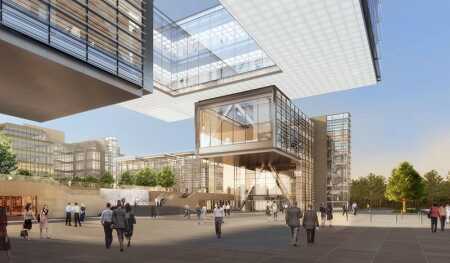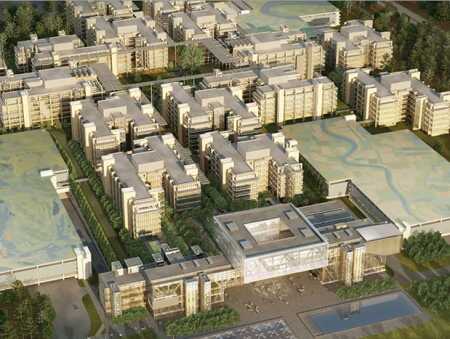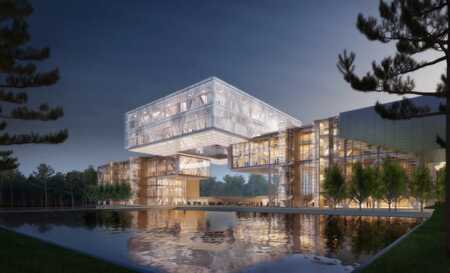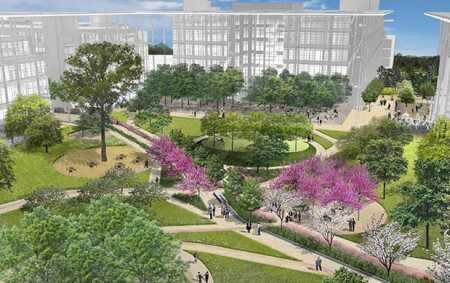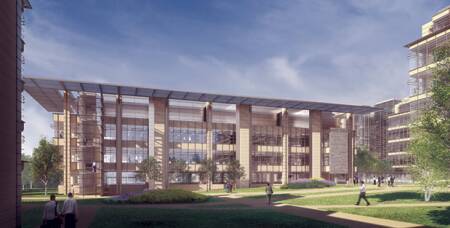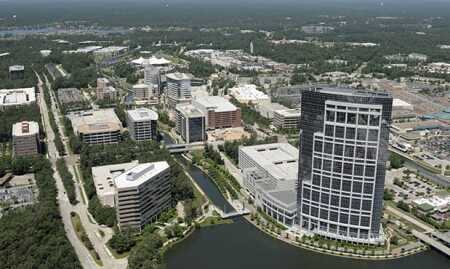Beginning like a spy novel might, an anonymous inquiry led to one of the largest and most transformative real estate developments in the history of Houston. The deal was code-named “Project Delta,” and the caller claimed to be representing a Fortune 500 company searching for a site for a massive corporate campus.
Aerial photography had revealed a large tract of wooded land 20 miles (32 km) north of downtown Houston, near Interstate 45, not far from George Bush Intercontinental Airport. The Woodlands, a nationally known master-planned community and census-designated place, also lay close to the site. The unidentified Fortune 500 company was very interested in this sizable, rare jewel of vacant, wooded land close to the nation’s energy capital.
The owner of the tract, CDC Houston, had heard it all before. Over the years, the developer had fielded proposals for a NASCAR racetrack and ideas from dozens of other would-be buyers, says Keith Simon, executive vice president and director of development for CDC Houston. But the offers had always been weak.
This time, however, the buyer turned out to be a bona-fide corporate user—ExxonMobil, which today is putting the finishing touches on a 20-building, 3 million-square-foot (279,000 sq m), 385-acre (156 ha) corporate campus where 10,000 employees will work.
“ExxonMobil contacted us in the middle of 2008. It was very secretive; there were no names disclosed at all,” Simon says. “They said they liked our location a lot, but they were concerned that we had no master plan, no infrastructure.
“Our simple response was: ‘Well, if you are who you say you are, we’re interested. Let’s get together and figure out where you want to be on the 2,000 acres. And we will create the master plan for the community in one month,’ ” Simon recalls saying. “So that’s what we did.”
Although CDC Houston did not know the name of the buyer, the developer held a secret design charrette in Houston with CDC’s master planner, Denver-based Design Workshop, and its mysterious would-be client. A couple of ExxonMobil employees attended the charrette without identifying themselves or their employer.
The process was secretive, but it worked. ExxonMobil appreciated the vision of the newly created master plan. And CDC Houston, owned by Coventry Development Corporation of New York City, had found the right buyer for its long-held property. Having purchased the land in 1961, CDC had been patiently waiting for decades for a big job-creating anchor to kick off its development. ExxonMobil was it.
The sales price was not disclosed, but the gigantic land deal closed at the end of 2008.
“It’s a game-changer, no question about it,” says Houston-based NewQuest Properties broker Frank Fitzgerald, a qualified analyst who served as president of the Houston Association of Realtors in 1988 but did not broker the ExxonMobil deal. “It’s the biggest thing to impact this area in a long time.”
The development of new roads, retail spaces, housing, and commercial uses has been spurred, directly or indirectly, by construction of the new ExxonMobil campus.
Campus under Wraps
Even today, ExxonMobil officials remain tight-lipped about the new campus. About 4,000 employees are already working there, but the public, the media—and even other ExxonMobil employees—have not been allowed to tour it.
This much is known, however, based on ExxonMobil’s scant public statements: The campus, which has been under construction since 2011, will have 14 six-story office buildings that were purposely designed as mid rises in order to blend in with the surrounding forested landscape. The facility will feature a sizable laboratory, a 100,000-square-foot (9,300 sq m) wellness center, a conference facility, and a child development center. San Francisco–based Gensler is architect of record on a design team that includes Pickard Chilton of New Haven, Connecticut; Hargreaves Associates of San Francisco; and Houston-based PDR.
Designed to have a collegiate feel, the campus comprises a three-acre (1.2 ha), pedestrian-only central commons inspired by scouting trips to universities and other corporate campuses, says Houston architect Scott Ziegler, senior principal of Ziegler Cooper Architects.
With the commons plaza and open floor plans in the office interiors, ExxonMobil is fulfilling its goal of using campus design to encourage employee collaboration. “I think they’ve done a masterful job of creating a sense of community and communication,” Ziegler says. The buildings are situated in a way that no building is more than a five-minute walk away from any other building.
The campus will house ExxonMobil personnel devoted to energy exploration, refining, chemicals, corporate law, finance, and other aspects of the business. But it will not be housing the firm’s corporate headquarters. ExxonMobil chief executive officer Rex Tillerson snuffed out those long-rumbling rumors unequivocally in a speech before Houston business leaders last fall. ExxonMobil headquarters will remain in the Dallas suburb of Irving, Tillerson stated, and it will not be relocated to Houston, some 200 miles (322 km) to the south.
The ExxonMobil campus is expected to be substantially complete this summer, with the total workforce of 10,000 moved in by the end of June. About 2,000 employees are being relocated to Houston from the company’s 117-acre (47 ha) campus in Fairfax, Virginia, a remnant from when Mobil Corporation was headquartered in northern Virginia in the years before Mobil merged with Exxon in 1999. The Virginia property has been leased by the Inova hospital system for a cancer research and medical facility. A small number of employees are being moved to ExxonMobil’s new facility in Houston from Akron, Ohio, but the bulk of the workforce at the campus will be transferred from other offices around Houston.
Development in the Aftermath
As part of the move to the new campus, ExxonMobil is selling off several Houston properties that it has occupied for years—creating opportunities to redevelop properties once occupied by the world’s largest refiner and marketer of petroleum products.
ExxonMobil’s 45-story downtown Houston office tower, which was once the headquarters of Humble Oil & Refining, a predecessor to ExxonMobil, was sold to San Francisco–based Shorenstein Properties in 2013 and leased back by the energy company. Later this year, when ExxonMobil vacates that 1.2 million-square-foot (112,000 sq m) ExxonMobil tower, now referred to as 800 Bell, Shorenstein plans to redevelop the 1962-vintage office building in partnership with Griffin Partners of Houston, and advanced discussions about leasing the building to the city for use by the police and fire departments are occurring.
Redevelopment opportunities will also be pursued at the former ExxonMobil Chemical Company office campus being vacated by ExxonMobil in the Energy Corridor area on Houston’s west side.
The 37-acre (15 ha) chemical company site was sold in 2014 to PM Realty Group of Houston, which is planning a mixed-use project with high-rise office buildings, multifamily uses, retail space, and a hotel.
For the Houston economy, ExxonMobil’s importation of 2,000 jobs from out of state was a significant boost. Overall, the city’s economy gained 120,000 new jobs in 2014, with ExxonMobil contributing some of them.
But perhaps the biggest boost for the city is what ExxonMobil’s campus has done to heat up the real estate markets in city’s north and northwest sectors. While the primary job centers grew close to the city’s center, the northern part of the city had attracted its fair share of growth over the years. But the arrival of ExxonMobil supercharged the region. Dozens of new projects and real estate deals were spawned by it and by the accompanying northward growth of the city.
Other new projects and recently announced deals in the ExxonMobil orbit of influence include the following:
- Woodson’s Reserve, a 692-acre (280 ha) community, is being developed by Horsham, Pennsylvania–based Toll Brothers with partner Cernus Development of Houston. Slated to deliver lots to builders in 2015, Woodson’s Reserve will have 1,050 single-family homes and 30 acres (12 ha) for commercial development.
- Skanska USA Commercial Development acquired 14 acres (6 ha) of land for a 1 million-square-foot (93,000 sq m) office development, just south of the ExxonMobil campus. The site is appropriate for a build-to-suit corporate campus or a three-building office complex with multiple tenants, according to Skanska USA, a New York subsidiary of Skanska AB, a multinational corporation based in Stockholm, Sweden.
- Grand Central Park, a redevelopment of Camp Strake, an old Boy Scouts facility, is a 2,000-acre (809 ha) master-planned community under development by Houston-based Johnson Development. Johnson purchased the site, located off Interstate 45, from the Sam Houston Area Council Boy Scouts of America in 2013. Fidelis Realty Partners of Houston recently purchased 112 acres (45 ha) of the site from Johnson Development for a 750,000-square-foot (70,000 sq m) open-air retail project with big-box stores, restaurants, a grocery store, a fitness center, a proposed movie theater, and multiple pad sites, slated for a 2017 opening.
Boom in ExxonMobil’s Neighborhood
CDC Houston, the developer that sold ExxonMobil its site, is moving ahead with developing its 2,000-acre (809 ha), mixed-use Springwoods Village project, which surrounds the energy firm’s campus. When finished in a decade or so, CDC Houston says, some $10 billion of development will be in place in Springwoods Village.Since ExxonMobil broke ground on its campus four years ago, the velocity of new projects being announced, planned, and started in Springwoods Village has been remarkable, as the prospect of being next door to ExxonMobil, or even within walking distance of its campus, proved to be a strong draw.
Just a few hundred feet from ExxonMobil, Springwoods Village attracted the new corporate headquarters of Southwestern Energy, a company primarily engaged in natural gas and crude oil exploration and production that moved into a new 515,000-square-foot (48,000 sq m) building in December. Houston-based Patrinely Group developed the building, which is used by 1,500 Southwestern Energy employees.
Patrinely and USAA Real Estate Company of San Antonio, in partnership with CDC Houston, plan to develop a lot more in Springwoods Village in a 60-acre (24 ha) commercial section called CityPlace. Long-range plans call for 4 million square feet (372,000 sq m) of office, retail, multifamily, and hotel space. For the short term, Woodbine Development of Dallas is planning three hotels in Springwoods Village, and Fein, a Houston apartment firm led by Martin Fein, is developing two multifamily rental projects, the first of which was completed last summer.
All of this fast-paced development immediately adjacent to ExxonMobil’s campus represented some top-dollar land deals in Springwoods Village. But the biggest deal of all may have been a donation of land to the state government.
CDC Houston donated 125 acres (51 ha) to the Texas Department of Transportation for an extension of State Highway 99, also known as the Grand Parkway.
With this donated land on the southern part of Springwoods Village, the state gained the impetus to begin constructing a 38-mile (61 km) extension of the Grand Parkway.
The $1.1 billion, four-lane highway, when completed in late 2015, will pass right by the ExxonMobil campus and allow the energy company’s employees to commute easily from northwest and northeast Houston.
“It’s good for everybody. Obviously it was good for us and good for the region,” says Simon, the Springwoods Village developer. “It’s really icing on the cake to have that major east–west connector.”
A Grand Highway
The Grand Parkway will do more than simply funnel ExxonMobil employees to work. It will open up vast swaths of land in north, northwest, and northeast Houston to development—areas that comprise dense suburbia, some commercial uses, and even prairie.
Citing the accessibility being created by the Grand Parkway, Newland Communities, a San Diego–based developer, announced plans last fall for Elyson, a 3,600-acre (1,500 ha) community where homebuilding is expected to start in 2016.
The Grand Parkway is attracting retail center developers, which are also getting in line to secure a place among the new rooftops.
New Hyde Park, New York–based Kimco Realty recently announced plans to develop Grand Parkway Marketplace, a 400,000-square-foot (37,000 sq m) “power center” with pads and restaurants.
In addition, Regency Centers, a Jacksonville, Florida–based firm, recently announced plans for a 385,000-square-foot (37,000 sq m) center at the corner of the Grand Parkway and Holzwarth Road, just south of the ExxonMobil site.
Even on the northeast side of Houston, the Grand Parkway has ignited commercial deals, including the 240-acre (97 ha) Valley Ranch Town Center, a 1.5 million-square-foot (139,000 sq m) retail center under development by Houston-based Signorelli Company. The project is about ten miles (16 km) northeast of the ExxonMobil campus.
The Woodlands, the aforementioned 28,000-acre (11,000 ha) master-planned community located about five miles (8 km) north of the ExxonMobil site, has seen strong growth, and the single-family inventory there is tight.
The Woodlands, however, is nearing buildout after a 40-year run as one of the best-selling communities in the nation—a new town development with 33,000 completed single-family homes, about 3,700 townhouses and condominiums, a regional mall, hotels, rental apartments, plus 131 parks, 21 public schools, and 43 religious congregations. Its population has surpassed 100,000, and its new homes, priced from around $300,000 to more than $4 million, are on the shopping list of many of the ExxonMobil employees who search for houses near the campus.
With its history of attracting businesses to the northern suburbs, the well-known master-planned community paved the way for ExxonMobil to consider the north side of Houston. The Woodlands had 7 million square feet (650,000 sq m) of prime office space, which was 95 percent occupied at the end of 2014, according to brokerage company CBRE. And five more office projects, totaling 1.2 million square feet (112,000 sq m), are under construction.
The Woodlands, with its significant supply of Class A office space—including two office towers totaling 1.4 million square feet (130,000 sq m) for the headquarters of Anadarko Petroleum Corporation—had become a desirable locale for corporate headquarters or the regional offices of major companies.
The Second Energy Corridor
Although the Houston economy became one of the nation’s strongest growth markets in recent years, when ExxonMobil bought the land for its campus in late 2008, Houston was beginning to cool off.
The city’s office market was weak during the recession of 2009, with the overall office vacancy rate approaching 20 percent in 2010.
But then the energy industry went into boom mode. Domestic energy exploration and production soared as innovations in drilling oil wells—horizontal drilling and hydraulic fracturing or “fracking”—made Texas, once again, one of the world’s richest producers of oil and gas. Oilfields that were once deemed useless became fonts of “black gold” because they could be fracked. Some called it the “shale revolution” because underground formations of shale rock were being tapped for oil with unconventional methods.
Houston, known as the Energy Capital of the World, supplied the brains and the brawn for the boom. On the industrial east side of the city, 24-hour shifts of blue-collar workers labored to produce oilfield equipment, and at the Port of Houston, importation of steel hit record highs.
The brains behind the energy boom—geologists, engineers, and analysts—operate in Houston office buildings. During the recent boom, the city led the nation in job growth and population growth, and its office market was on fire. Oil was at $100 a barrel—long before prices cratered late in 2014—and Houston was humming.
The north side of Houston caught its share of the energy-fueled growth wave. The Woodlands, near the ExxonMobil site, saw its office space fill up fast. The master-planned community’s Class A office space—totaling about 5 million square feet (465,000 sq m)—went to 99 percent occupancy by 2012, surging from 80 percent occupancy just three years earlier, according to Colliers International.
With demand high, developers responded with a spate of new office projects in north Houston, near the ExxonMobil project and farther north.
Since the 1970s, the section of western Houston along Interstate 10 had been known as the Energy Corridor, a massive submarket with almost 30 million square feet (2.8 million sq m) of office space housing energy giants such as Shell Oil, BP America, ConocoPhillips, and myriad other firms.
Energy companies are scattered across Houston and occupy major towers downtown, but the Energy Corridor of west Houston is held in high regard because of its absolute massing of energy companies and the engineering firms and vendors that support them.
Then came the northward shift. With the development of the ExxonMobil facility, north Houston secured its place as a preferred locale for the energy business—a Second Energy Corridor for the city, along with the established Energy Corridor in west Houston.
“Having two Energy Corridors is good for Houston because it spreads the employment base all around the city, not just in one area,” says land broker Stan Creech of Houston-based Stan Creech Properties. “We spend a lot of time in west Houston, which is the original Energy Corridor. But Houston now definitely has two Energy Corridors.”
The shift of momentum to the north was pushed into high gear by the scale of ExxonMobil’s campus: 20 buildings under construction simultaneously—an unprecedented and concentrated growth injection the likes of which the city may never see again, Creech says.
“The ExxonMobil campus is the Super Bowl of Houston real estate. It’s unbelievable. We’ve never had 10,000 people moving into one project. It’s huge,” Creech said. “It’s probably the biggest thing ever to happen in Houston.”
Ralph Bivins, a Houston-based journalist, is editor of Realty News Report, an award-winning website and e-newsletter.

